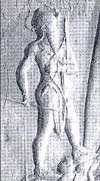METEOR
CLUE TO END OF
MIDDLE EAST CIVILISATIONS
BY
ROBERT MATTHEWS
Sunday Telegraph – 16th November 2001
 SCIENTISTS
HAVE found the first evidence that a devastating meteor impact
in the Middle East might have triggered the mysterious collapse
of civilisations more than 4,000 years ago. SCIENTISTS
HAVE found the first evidence that a devastating meteor impact
in the Middle East might have triggered the mysterious collapse
of civilisations more than 4,000 years ago.
Studies
of satellite images of southern Iraq have revealed a two-mile-wide
circular depression which scientists say bears all the hallmarks
of an impact crater. If confirmed, it would point to the Middle
East being struck by a meteor with violence equivalent to hundreds
of nuclear bombs.
Today’s
crater lies on what would have been shallow sea 4,000 years
ago, and any impact would have caused devastating fires and
flooding.
The
catastrophic effect of these could explain the mystery of why
so many early cultures went into sudden decline around 2300
BC. They include the demise of the Akkad culture of central
Iraq, with its mysterious semi-mythological emperor Sargon;
the end of the fifth dynasty of Egypt’s Old Kingdom, following
the building of the Great Pyramids and the sudden disappearance
of hundreds of early settlements in the Holy Land.
Until
now, archaeologists have put forward a host of separate explanations
for these events, from local wars to environmental changes.
Recently, some astronomers have suggested that meteor impacts
could explain such historical mysteries.
The
crater’s faint outline was found by Dr Sharad Master, a
geologist at the University of Witwatersrand, Johannesburg,
on satellite images of Al Amarah region, about 10 miles north-west
of the confluence of the Tigris and Euphrates, and home of the
Marsh Arabs.
“It
was a purely accidental discovery,” Dr Master told The
Sunday Telegraph last week. “I was reading a magazine
article about he canal-building projects of Saddam Hussein,
and there was a photograph showing lots of formations –
one of which was very, very circular.”
Detailed
analysis of other satellite images taken since the mid-1980s
showed that for many years the crater contained a small lake.
The draining of the region, as part of Saddam’s campaign
against the Marsh Arabs, has since caused the lake to recede,
revealing a ring-like ridge inside the larger bowl-like depression
– a classic feature of meteor impact craters.
The
crater also appears to be, in geological terms, very recent.
Dr Master said: “The sediments in this region are very
young, so whatever caused the crater-like structure, it must
have happened within he past 6,000 years.”
Reporting
his finding in the latest issue of the journal Meteoritics
& Planetary Science, Dr Master suggests that a recent
meteor impact is the most plausible explanation for the structure.
A
survey of the crater itself could reveal tell-tale melted rock.
“If we could find fragments of impact glass, we could date
them using radioactive dating techniques,” he said.
A
date of around 2300 BC for the impact may also cast a new light
on the legend of Gilgamesh, dating from the same period. The
legend talks of “the Seven Judges of Hell,” who raised
their torches, lighting the land with flame, and a storm that
turned day into night, “smashed the land like a cup,”
and flooded the area.
The
discovery of the crater has sparked great interest among scientists.
Dr
Benny Peiser, who lectures on the effects of meteor impacts
at John Moores University, Liverpool, said it was one of the
most significant discoveries in recent years and would corroborate
research he and others have done.
He
said that craters recently found in Argentina date from around
the same period – suggesting that the Earth may have been
hit by a shower of large meteors at about the same time.
|